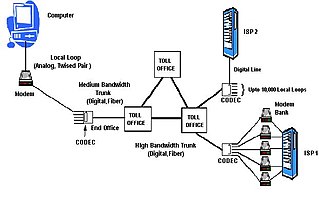The People's Republic of China possesses a diversified communications system that links all parts of the country by Internet, telephone, telegraph, radio, and television. The country is served by an extensive system of automatic telephone exchanges connected by modern networks of fiber-optic cable, coaxial cable, microwave radio relay, and a domestic satellite system; cellular telephone service is widely available, expanding rapidly, and includes roaming service to foreign countries. Fiber to the x infrastructure has been expanded rapidly in recent years.

The telecommunications in Russia has undergone significant changes since the 1980s, radio was a major new technology in the 1920s, when the Communists had recently come to power. Soviet authorities realized that the "ham" operator was highly individualistic and encouraged private initiative – too much so for the totalitarian regime. Criminal penalties were imposed but the working solution was to avoid broadcasting over the air. Instead radio programs were transmitted by copper wire, using a hub and spoke system, to loudspeakers in approved listening stations, such as the "Red" corner of a factory. This resulted in thousands of companies licensed to offer communication services today. Due to the enormous size of the country Russia today, the country leads in the number of TV broadcast stations and repeaters. The foundation for liberalization of broadcasting was laid by the decree signed by the President of the USSR in 1990. Telecommunication is mainly regulated through the Federal Law "On Communications" and the Federal Law "On Mass Media"

Telecommunications in Azerbaijan provides information about television, radio, fixed and mobile telephones, and the Internet in Azerbaijan. The Azerbaijan economy has been markedly stronger in recent years and, not surprisingly, the country has been making progress in developing ICT sector. Nonetheless, it still faces problems. These include poor infrastructure and an immature telecom regulatory regime. The Ministry of Communications and Information Technologies of Azerbaijan (MCIT), as well as being an operator through its role in Aztelekom, is both a policy-maker and regulator.
Digital subscriber line is a family of technologies that are used to transmit digital data over telephone lines. In telecommunications marketing, the term DSL is widely understood to mean asymmetric digital subscriber line (ADSL), the most commonly installed DSL technology, for Internet access.

In telephony, the local loop is the physical link or circuit that connects from the demarcation point of the customer premises to the edge of the common carrier or telecommunications service provider's network.

Telecommunications in Armenia involves the availability and use of electronic devices and services, such as the telephone, television, radio or computer, for the purpose of communication. The various telecommunications systems found and used in Armenia includes radio, television, fixed and mobile telephones, and the internet.
Plain old telephone service (POTS), or plain ordinary telephone system, is a retronym for voice-grade telephone service employing analog signal transmission over copper loops. POTS was the standard service offering from telephone companies from 1876 until 1988 in the United States when the Integrated Services Digital Network (ISDN) Basic Rate Interface (BRI) was introduced, followed by cellular telephone systems, and voice over IP (VoIP). POTS remains the basic form of residential and small business service connection to the telephone network in many parts of the world. The term reflects the technology that has been available since the introduction of the public telephone system in the late 19th century, in a form mostly unchanged despite the introduction of Touch-Tone dialing, electronic telephone exchanges and fiber-optic communication into the public switched telephone network (PSTN).

Tele-Communications, Inc. (TCI) was a cable television provider in the United States, and for most of its history was controlled by Bob Magness and John Malone.

GCI Communication Corp (GCI) is a telecommunications corporation operating in Alaska. Through its own facilities and agreements with other providers, GCI provides cable television service, Internet access, wireline (networking), and cellular telephone service. It is a subsidiary of Colorado-based company Liberty Broadband, a company affiliated with Liberty Media that also owns a 26% interest in Charter Communications, having been originally acquired by Liberty in 2015.
Rochester Telephone Corporation was a company that provided local telephone service to Rochester, New York. The company was founded in 1920 as a merger of Rochester Telephonic Exchange and Rochester Telephone Company. In 1995 the company became Frontier Corporation, trading on the NYSE under the FRO symbol. Ownership passed to Global Crossing in 1999, and then, in 2001, to Citizens Utilities Corporation, which later changed its name to Frontier Communications.

Telecommunications Services of Trinidad and Tobago Limited is a large telephone and Internet service provider in Trinidad and Tobago. The company, which is jointly owned by the Government of Trinidad and Tobago and Cable & Wireless Communications, was formed out of a merger of Telco and Textel. TSTT no longer holds a monopoly in fixed-line telephone services due to FLOW introducing a fixed-line service of their own, and their cellular monopoly was broken in June 2005 when licenses were granted to Digicel and Laqtel.

Midco is a regional cable provider, providing a triple play service of cable television, Internet and telephone service for both North Dakota and South Dakota, along with much of Minnesota, and several communities in Kansas and Wisconsin. The company's business-class service also provides direct fiber-optic communications services via leased data circuits for larger companies.

Frontier Communications Parent, Inc. is an American telecommunications company. Known as Citizens Utilities Company until 2000, Citizens Communications Company until 2008, and Frontier Communications Corporation until 2020, as a communications provider with a fiber-optic network and cloud-based services, Frontier offers broadband internet, digital television, and computer technical support to residential and business customers in 25 states. In some areas it also offers home phone services.

RCN Corporation, originally Residential Communications Network, founded in 1993 and based in Princeton, New Jersey, was the first American facilities-based ("overbuild") provider of bundled telephone, cable television, and internet service delivered over its own fiber-optic local network as well as dialup and DSL Internet service to consumers in the Boston, Chicago, Los Angeles, New York City, the Lehigh Valley in eastern Pennsylvania, and Washington, D.C. areas.
Telecommunications in Hungary include radio, television, fixed and mobile telephones, and the Internet.
CentraCom Interactive is a telecommunications company, which provides fiber-optic communication, cable internet, wireless broadband, DSL service, phone service, and cable TV to much of central, north and western Utah. CentraCom is DBA of Central Utah Telephone, Inc.
SRT Communications is the largest telecommunications cooperative in North Dakota, serving customers with Internet, Security Alarm and Video Surveillance, Phone, and Business Phone Systems and services.
Lumos is a telecommunications provider, based in Waynesboro, Virginia; and High Point, North Carolina, United States, offering landline and cellular telephone, residential and business optical fiber services, web hosting, yellow pages, and digital television. The company announced a merger with North State Communications effective August 15, 2022.
Shentel, officially Shenandoah Telecommunications Company, is a publicly traded telecommunications company headquartered in Edinburg, Virginia. It operates a digital wireless and wireline network in rural Virginia, West Virginia, Maryland and Pennsylvania.

Frontier Fiber is a bundled Internet access, telephone, and television service that operates over a fiber-optic communications network. Service is offered in some areas of the United States by Frontier Communications in areas built out and formerly served by Verizon, using the same infrastructure as its Fios service. Other service providers often use fiber optics in the network backbone and existing copper or coax infrastructure for residential users. Frontier's service began in 2009 with the acquisition of portions of Verizon's network, and networked areas expanded through 2015 through similar acquisitions, although some areas do not have service or cannot receive TV and phone service because of franchise agreements.














